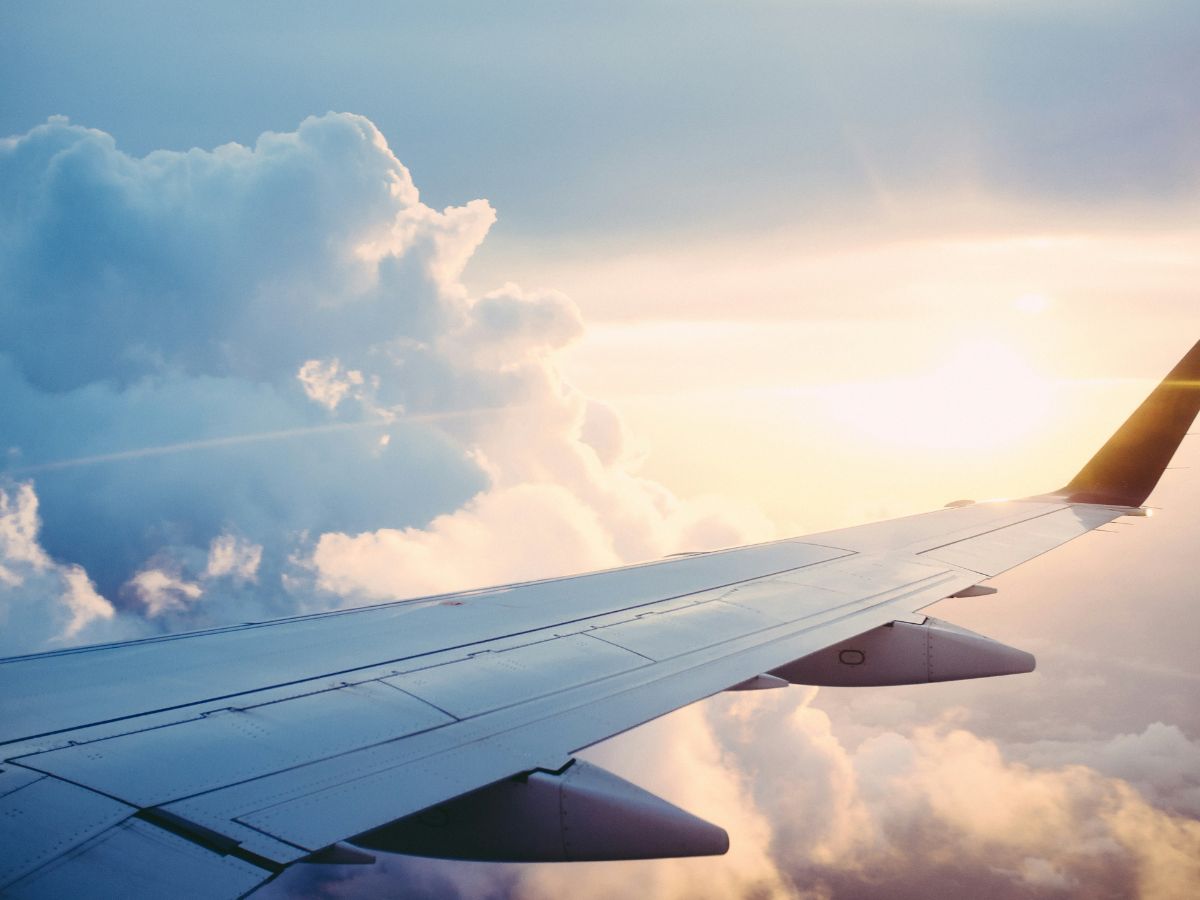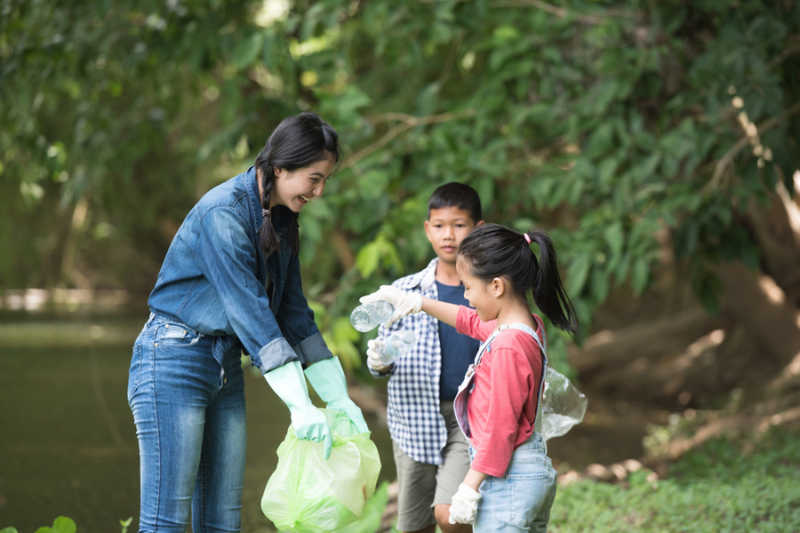Getting ready for your little one’s inaugural flight? To help the trip go as smoothly as possible, check out these top tips for travelling with an infant.
[Feature image credit: Ross Parmly via Unsplash]
For even the most seasoned parents, travelling with kids can feel both impossible and exhausting. That said, you shouldn’t let having a baby get in the way of your holiday plans. To help you prepare and survive the journey, we’re compiled a list of practical tips and tricks for flying with a young baby. Read on as we cover everything from flight scheduling and what to pack to managing jet lag in babies and more.

Before we get started, you might be wondering when your baby is old enough to fly on an airplane.
Typically, airlines will insist that your baby is at least two weeks old before travelling. However, most paediatricians would recommend that you wait until your baby is two or three months old to fly, on account of their delicate immune systems. Airline policies do tend to vary on this, so be sure to check your intended carrier’s age requirement before booking.
Read more: When is it Safe to Travel with my Baby?
Other factors to consider before booking a flight for your little one include:
- Your recovery after giving birth.
- The baby’s overall health.
- The turnaround time of your baby’s passport.
- The timing of your baby’s vaccinations.
Flying with a Baby: What You Need to Know
If you’re nervous about an upcoming trip, you’re not alone. But a little preparation can take some of the worry out of traveling with babies and young kids. Read on, as we share our essential tips and items to ensure a smooth, stress-free journey.
Pre-Flight Considerations
Before you book anything, make sure that you familiarise yourself with the rules for flying with a baby on your preferred airline as different airlines and countries have different policies and processes for flying with an infant.
Also, when booking a seat for your child, do look into the airline’s loyalty programme to see whether your child is eligible to earn points or not. Most airlines will allow you to sign them up from birth, though they won’t be able to actually earn miles until you purchase them their own seat.
Fees
Children under 2 are usually allowed to be brought on as a lap infant. Lap infants can typically travel for free or at a discounted fare if travelling internationally.
Travel Documents
- Passport. Be sure to organise your child’s passport well ahead of time as you’ll want to account for lengthy processing times and mailing times. Moreover, that first passport requires a lot of documents (and with that, often a lot of back-and-forth), so it’s best to always err on the side of caution.
- Proof of age documentation. Some airlines may require proof of age documentation for babies and children under 18, so we always bring our children’s birth certificates along, just in case, as well as their immunisation records.
- Letter of consent. For those travelling as a solo parent, it’s strongly recommended that you bring along with you a notarised letter granting parental permission.

Flight Time When Flying with a Baby
Avoid flights that mess with your baby’s schedule. If possible, try to book flights to coincide with your baby’s normal sleep times. This is especially important for long-haul flights. If, however, you’re overly concerned about your baby being noisy, then you may want to consider flying during the day as you’re less likely to be interrupting passengers’ sleep.
Non-Stop vs. Connecting Flight?
There are pros and cons to layovers with children. Those with active kids often prefer to break their journey into parts, as the layover can provide a welcome break from the monotony of being cooped for hours on end. However, these connecting flights do come with the added risk of flight delays, cancellations, misconnects, and lost baggage.
With non-stops, on the other hand, the logistics of flying with kids are so much easier, and the overall travel time is shorter. So if you know that your child is a good sleeper, then this is probably the option for you.
Seat Selection When Flying with a Baby
There is no real right or wrong selection here, as it all depends on your baby. Nonetheless, here is a quick overview of the pros and cons of various popular seat selections when travelling with an infant.
- Bulkhead seats. Many like to opt for those front-row bulkhead seats as they allow for more legroom for you and floor space for baby to potentially play in. Depending on the age and size of your baby, you can also request a bassinet if available, which would provide your baby with its own sleep space. On the flip side, these seats come at the expense of storage, meaning that all your bags will have to be kept in the overhead bins, making it all the trickier to access diapers, milk, and anything else you might need in a pinch. Furthermore, the arm rests in bulkhead seats don’t move which can be awkward and less comfortable.
- Window seats. The second best option, in our opinion, are window seats, as the views can provide additional entertainment / distraction for the child throughout the journey. They also feel ever so slightly roomier than aisle seats, and provide more privacy for breastfeeding mummas. Note that if you use a car seat, most airlines will require that they be installed in a window seat.
- Aisle seats. If your baby requires a lot of movement and soothing, then an aisle seat may be right for you. Not only are these more convenient for quick ups and downs, but they also lessen the amount you may disturb your neighbour. However, keep in mind that you will be sat under the overhead bins which does come with some risk, and the constant traffic down the aisles (especially during beverage service) can potentially be disturbing.
- Location. When selecting your seats, do take into consideration its proximity to the bathrooms and galley. While some parents may like the extra standing room that these nearby areas afford, others will despair over the additional noise and lights.
It’s worth mentioning that airlines typically only allow one lap infant per row. So if you have twins / 2 babies under 2 and are travelling with your partner, you won’t be seated in the same row.

Deciding Between Lap Infant vs Seat Purchase
While you don’t officially need to purchase a ticket for children under 2, experts agree that it’s much safer to buy an airplane seat for your baby, than to have them sit on your lap. Plus, you’ll both probably enjoy the flight more, too!
If you do decide to purchase a seat for your baby, make sure you bring an FAA-approved child restraint with you to safely strap them in. Alternatively (and this is our preference), you can bring a rear-facing car seat that’s FAA compliant. With that said, if you kid doesn’t like their car seat in the car, they’re probably not gonna like their car seat on the plane, so do bear that in mind…
*Note that not all carseats are approved for use on airlines, so be sure to check the label beforehand.
Can’t stomach the cost of buying an extra seat? You can always try your luck on the day by asking the gate agent if there are any open seats on the plane.
If you choose to fly with your baby on your lap, you’ll likely be provided with a special seat belt for your infant that connects to your seatbelt. While you can use a baby carrier during the flight, you will have to remove the baby from the carrier whenever the seatbelt sign is turned on.
You might also be interested in reading: Which Baby Carrier is Best for You?

Bassinets on Planes
A bassinet is a baby bed that attaches to the bulkhead of a plan to give parents a safe place to put their baby down during the flight. They are usually available on international flights free of charge, and can be requested during the booking process of through customer service channels. Bassinets are subject to availability and usually offered on a first-come, first-serve basis, so be sure to request one early to avoid disappointment.
Typically, bassinets are only designed for babies up to 12kg that can’t yet sit up unassisted. As such, larger babies will have to make do on mum or dad’s lap, or in their own seat.
Parents should note that for safety reasons, bassinets are stowed away during turbulence, take-off, and landing.
Baggage Allowance
If you have purchased an extra seat for your baby, then that ticket includes the same baggage allowance as adults in the same travel class.
Infants without a reserved seat, on the other hand, may or may not receive baggage allowance – it all depends on your particular airline’s policies on hand luggage and check-in luggage, so definitely check on this before travel.
Regardless of your ticket, all airlines will allow you to check at least a car seat or a stroller – with the majority allowing both, free of charge.
Hand Luggage – Pack Light and Pack Carefully
Seriously! We know babies come with a lot of stuff, but do your best to only pack the true essentials. The last thing you want in a crisis is to have to rummage through a big bag to find everything you need.
For added convenience, we highly recommend forgoing your large and bulky diaper bag in favour of several smaller to-go diaper kits. These are small ziplock bags that include diapers, baby wipes, and disposable bags for dirty nappies. Plan to have enough diapers for the duration of the flight and allow for extras in case of delays or unexpected explosions. Oh, and strongly consider bringing a portable changing mat or disposable puppy pads, as changing tables (if the plan even has one) are usually hard, cold, and possibly dirty.
On the topic of blowouts, always pack more clothes than you think you need for baby. Dress your child in easy-to-remove clothes, like onesies with front snaps and wide necks, and avoid anything that needs to be pulled over the head. And think: layer, layer, layer!
What to Pack in Your Carry On When Flying with a Baby
Here’s a full list of items we like to include in our hand luggage when travelling with a baby:
- Diapers. Twice as many as you think you need in case of delays! We also like to include a bunch of overnight diapers for higher absorption.
- Wipes. Again, always pack more than you need.
- Nappy cream. Portioned into a small container to save space.
- Nappy bags. Aside from the obvious, these are also handy for collecting little bits of rubbish or dirty/wet clothing.
- Breast milk or formula. If bringing formula, we tend to proportion them out in a handy formula dispenser, and bring along a large thermos of pre-boiled water (cooled down to a drinkable temperature).
- Bottles. Some parents like to bring sterilising tablets and wash (with bottled water) as they go in a resealable bag, but we prefer to just bring more bottles than we need and start anew each time.
- Pumping equipment & wipes. (Disregard if not pumping)
- Bibs. If you’ve got a drooler, bring several.
- Baby clothes. At least 2 extra outfits, if not more. We like zip up, footed sleep suits, plus bodies/vests for layering.
- Blankets. A soft, lightweight blanket or swaddle to keep baby warm and cosy during the flight (plus 1 for back-up!).
- Disinfectant wipes. For cleaning tray tables and other surfaces.
- Hand sanitiser. Opt for a non-alcohol formula to keep the whole family clean and germ-free (avoid applying directly to a baby under 1 years old).
- Portable changing mat. While any would work (including disposable puppy pads), we like ones that come with a cushioned part for the head, and pockets to pack one or two nappies + wipes.
- Snacks. Handy for keeping little ones occupied and satiated, especially in the case of delays.
- Entertainment. Toys, teethers, and whatever else keeps your baby happy and amused!
- Comforter. If your baby has something that soothes them, then you’ll definitely want to bring that along. And as with most things on this list, it’s worth bringing a duplicate in case of spills / it goes missing.
- Pacifier. Clipped on to you baby before we go, plus a spare in the bag.
- A change (or two!) of clothes for mum.
- All necessary travel documents.
- A first-aid travel kit. This may include infant painkillers like Tylenol, antiseptic cream or spray, and nasal aspirators.
Sleep
It’s no secret that sleep is a big reason why many parents dread travelling with a baby. If you have a young baby under 3 months old, you’re in luck, as their sleep shouldn’t be too impacted by the journey. For those with older babies, you’re going to want to bring along any sleep associations, such as their sleeping bag, white noise machine, pacifier, and comforter, to help them settle into their usual sleep routine. And if using a bassinet, you may also consider purchasing an airline bassinet cover to help block out any light and further distractions on a long haul flight.
Jet Lag
While there’s no miracle cure to jet lag, there are some steps you can take to lessen its impact.
- Try gradually adjusting your baby’s sleep schedule a few days before you leave. Depending on the time difference, this may involve moving your baby’s sleep and general routine earlier or later by 15-30 mins per day. Once you get to your destination, immediately change to that new timezone.
- If you arrive in the morning, encourage maximum exposure to daylight, regular feedings, and ample social activity to reset that circadian rhythm.
- If you arrive in the evening, try to get your baby down at their usual bedtime in the new time zone. Follow your usual sleep routine (remember, consistency is key with babies!).
- Do not allow your little one to nap any more than usual, no matter how much they will want to. They need to be tired enough to have the right amount of sleep pressure to sleep through the night, but not so sleep deprived that they’re overtired.
- Stick to a similar bedtime routine to the one you have at home. Routines are reassuring to babies and reinforce their natural circadian rhythms.
- When your baby inevitably wakes up during the night, keep the room dim and interaction to a minimum. The atmosphere must remain calm as you try to help them settle back to sleep. If all else fails, just while away the time in the dark. This signals that it is in fact nighttime, not daytime.
At the Airport
Arrive early! This is crucial. Arriving early at the airport gives you plenty of time to check in, pass through security, and make your way to your gate – all things that take a lot longer when flying with a baby.
Some airports have fast-track queues for families travelling with young children. If, however, you are faced with a long queue at check-in, we suggest that one adult queues while the other entertains the children elsewhere, rejoining the queue at the last minute.
Travelling with a Stroller and/or Carseat
Here are some options when flying with a baby car seat and/or stroller:
-
Check either your car seat and/or stroller at the gate. In our opinion, this is the best option when travelling with a stroller as you still get to use it in the terminal itself and upon deplaning, but without the hassle of trying to drag it (and all your other essentials!) down the airplane aisle and then wrestle it up into the overhead bins. Plus, gate checked items have a lower risk of being lost or damaged compared to regular checked baggage.
-
Check your car seat and/or stroller at baggage check. If you don’t intend on using your car seat on the flight and prefer babywearing through security, then you can consider checking your car seat and/or stroller at the ticket counter.
-
Bring both/either on board with you. Most airlines allow small, collapsible strollers to be brought on board free of charge and stowed in the overhead compartments. These cabin-approved strollers and car seats typically don’t count towards your carry-on baggage allowance.
Most airlines allow one stroller and one car seat to be checked for free per child. Regardless of your method of checking, be sure to get a stroller bag and car seat cover before you travel to avoid any inevitable scuffing and dirt.
Unfortunately, airlines have been known to damage and even lose strollers, regardless of whether they were checked in at baggage check or at the gate. With that in mind, we’d recommend leaving the fancy stroller at home and travelling with a cheaper model, if possible.
Going Through Security
You’ll have to remove your baby from your stroller / car seat and carry them in your arms when going through the metal detector at airport security. For that reason, we like to use a baby carrier throughout the airport and onto the plane as you’re usually allowed to babywear when walking through the scanners. If your security check coincides with nap time, it’s best to get your baby in the baby carrier earlier so as to avoid having to wake a sleeping baby.
Don’t worry about your breast milk or formula + water. They are not subject to the same quantity limitations that other liquid are, so you can bring the amount you need (plus extra in case of delays!). Just remember to let the security agent know if you have any baby milk/food over 100ml as this may need to be checked separately. Depending on where you are, they may swab the outside of the bottles to test for explosives residue or dip a test strip into the liquid. In some cases, you might be asked to do a taste test. Most of the time, however, they’ll simply put the bottles through the x-ray scanner like all your other hand luggage.
Boarding the Plane with Young Children
To Pre-Board or Not to Pre-Board?
Airlines tend to allow families with children to board early. On this policy, we’re in two minds. On the one hand, it can be tempting as it gives you extra time to settle your kids in their seats before the onslaught of other passengers, whilst also guaranteeing you ample overhead baggage space.
However, it also lengthens the amount of time your kids will be confined to one space. Which, as any parent knows, is far from ideal. So, if you’re lucky enough to be travelling with another adult, the best option would be for them to pre-board ahead of you with the bags, and for you and the kids to join later.

During the Flight
Feed During Takeoff and Landing
You’ve probably heard the good ‘ol trick of feeding the baby during takeoff and landing to help relieve the pressure in their ears and acclimate to the altitude change. But what if baby isn’t hungry? Then offer a pacifier. It’ll work the same.
Changing Baby on a Plane
Always change your baby just before boarding as you’ll have significantly more space in an airport bathroom than in a cramped aircraft lavatory.
Most planes will have at least one bathroom equipped with a changing table, so don’t forget to ask your cabin crew for its location once you’ve got on board. If you happen to be on a plane that doesn’t have a changing table, then you’ll have no option but to change your baby’s nappy on the closed toilet seat (hence the changing pad). Whatever you do, try and avoid changing baby in your seat out of respect for other passengers.
Bring Snacks
If baby is eating solids, then pack some healthy portable snacks like raisins, rice cakes, fruit, and puree pouches for the journey. Not only will they keep baby from being hungry, but they will also entertain them.
Bring Entertainment
Speaking of entertainment, don’t forget to pack a bag of small toys to keep older babies stimulated throughout the flight. We particularly love sensory toys, fidget spinners, and teethers for our little ones.
How to Help Baby Sleep on the Flight?
To maximise your chances of having your baby sleep well during the flight, do the following:
- Book a flight that coincides with when your baby normally sleeps.
- Avoid naps at the airport (while still avoiding over tiredness).
- Allow older babies to burn off energy at the airport.
- Bring all of baby’s sleep associations and do a little bedtime routine on the flight.
- If they don’t sleep in the bassinet / car seat, try walking around / rocking them in the baby carrier.
What to do if Your Baby Won’t Stop Crying?
Now for the question that everyone wants to know the answer to…What to do if your baby won’t stop crying? First of all, take a breath. Babies cry. Sure, there might be the odd passenger that gives you snarky look or audible sigh, but just try and ignore them. The majority of your fellow passengers will be understanding and sympathetic, or indifferent.
The next step is to try and figure out the cause of the crying. Are they hot? Cold? Hungry? Tired? Once you can pinpoint what’s the matter, you can then get working on the remedy. If that doesn’t work, give some of these tactics a go:
- Try walking up and down the aisle to calm them.
- Distract them with their favourite toy or a game of peek-a-boo.
- Let them look out the window and describe what you see.
- Offer a pacifier or toy to chew.
- Bounce your baby on your knee.
- Spend some time in the back of the plane (the engines are louder back there which will help to mask the noise).
And so concludes our roundup of tips on flying with a baby. Whether you’re flying with a newborn or 1 year old, long haul or short haul, the main thing is to just try your best to relax. Plan for delays, give yourself time, and accept help if it’s offered! You’ve got this!
Related articles:










